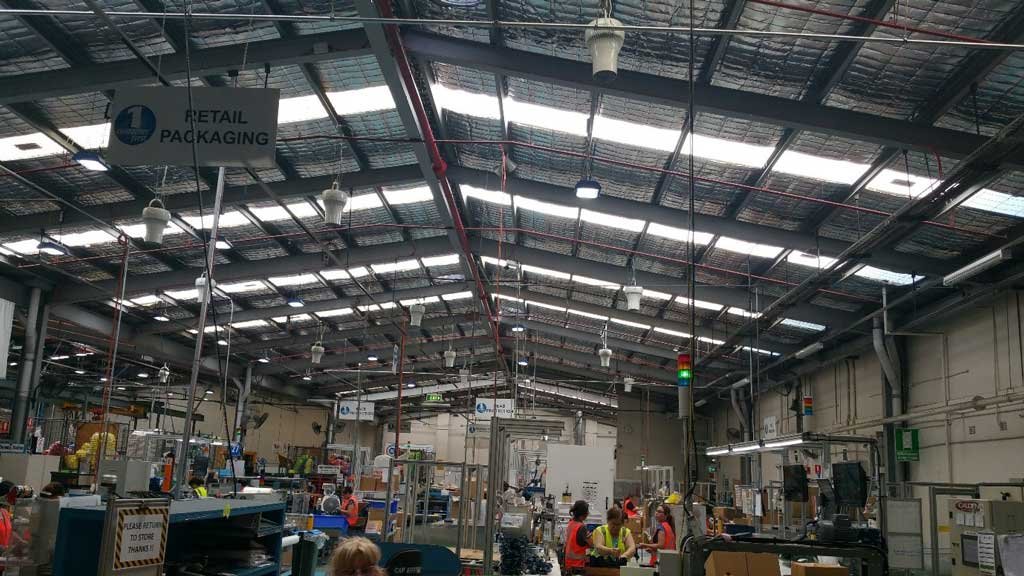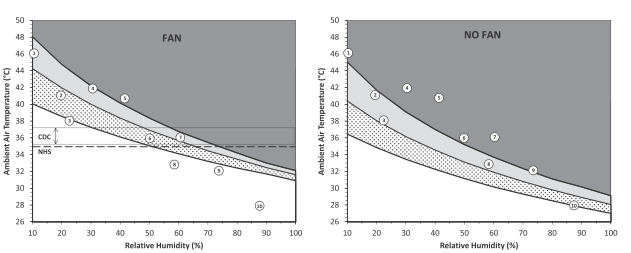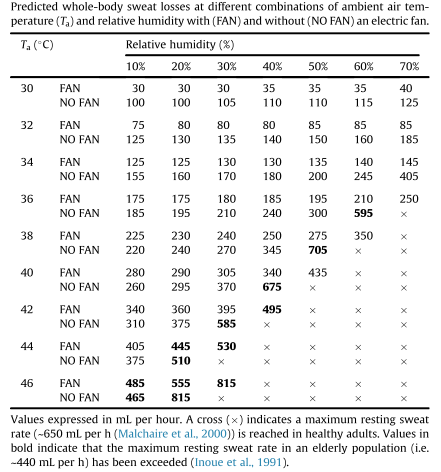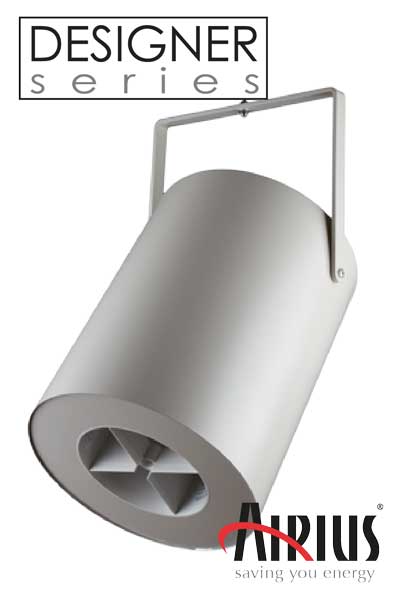
What does the science say?
As the temperatures around the world are becoming warmer, and let’s face it, it’s hard to deny the overall heating pattern, a clearer understanding of what thermal comfort requirements are under heatwave conditions becomes more necessary. If we don’t know how to deal with heatwaves, then of course building inhabitants will experience extreme discomfort and in worst case scenarios, may suffer severely from overheating. Death is possible under extreme heatwave conditions. This is because the main health outcome of overheating on the body is cardiovascular strain, as the body overworks to remove the heat in very poor heat removal conditions.
Thermal comfort
In order to maintain a fixed core body temperature, the human body must balance the rate at which it produces heat, arising as a by-product of cellular metabolism (approximately 80-100 W at rest), with the rate at which heat is dissipated to the surrounding environment. Human heat dissipation occurs via dry (i.e. conduction and convection) and latent (i.e. evaporation) avenues of heat transfer.
However, above certain temperatures, when the air is above the body’s temperature, (usually considered to be 35.5 Deg. C), the gradient for dry heat loss is reversed and heat is added to the body rather than lost. (O. Jay, M Cramer et al, 2015)
In Australia, the last 15 out of 17 years (BOM, 2018) have been the hottest on record. Anthropogenic climate change or not, the climate is changing and warm days are becoming more prolific and at consistently higher temperatures.
‘Climate projections show that extreme heat events are expected to occur more often and with greater intensity in the future’. BOM 2018.
Heatwaves are classified into three types, based on intensity; low, severe and extreme.
Once the heatwave reaches severe, that’s when impacts on the health of elderly, sick and young people, as well as infrastructure, will be experienced.
The Bureau of Meteorology (BOM) defines a heatwave as three or more days in a row when both daytime and night-time temperatures are unusually high—in relation to the local long-term climate and the recent past.
In many cases around Australia, the methodologies to improve thermal comfort at extreme temperatures may be limited.
Air conditioning certainly isn’t designed to deal with 45-55 Deg. C days, unless it is completely overdesigned, and even if it is, it will not necessarily be optimally effective at those extreme temperatures. It may, of course, be better than no air conditioning. But a lot of money is then spent on purchasing an oversized unit that may be only needed for 30 days a year. Plus, it will run very inefficiently for most of the usual climatic conditions it encounters.
However, not everybody can afford or wants air conditioning and air conditioning has zero effect in an open space like a stadium or bus stop or any other type of exposed, unenclosed shelter open to the outside environment?

So what can we do?
The use of fans to cool has been used for millennia and works on a simple principle. The air movement from the fan evaporates the moisture produced on the skin by the body as an attempt to cool itself. The more air movement generally the faster the cooling.
For example, if you go to a gym or ride your pushhbike during a very hot and humid day and create large amounts of perspiration, standing in front of a fan when perspiring offers an instant and rapid cooling effect, with a significant drop in perceived temperature and improved comfort.
This chart highlights some earlier research on the value of air movement for cooling in warm and humid environments.
As a fan engineering and manufacturing company, Airius is paying a lot of attention to the impact of heatwaves on the population. We follow as much scientific research as we can to ensure our knowledge is as up to date as possible around what makes people comfortable and how fans can assist with improving thermal comfort during those ridiculously hot days that are becoming more and more prevalent as each decade progresses.
Certainly, we do have a clear understanding as to what comprises thermal comfort and as we design our fan systems for both cold and warm climates, that understanding is influenced and informed by the most recent thermal comfort research.
Now what constitutes a heat wave varies from country to country.

In England, a heatwave may be 36 Deg C and humidity levels of 60 -70%.
In New York, it may be 43 Deg. C and 30-60% humidity. In Australia, 45-51 Deg. C and varying levels of humidity from 10-60% constitute a heatwave. And there will be many examples of those temperatures being experienced in non-conditioned spaces or zones, both internal and external.
Until very recently, many countries didn’t recommend the use of fans in heatwave conditions. The thermal comfort research and science around thermal comfort and those extreme temperatures was limited, hadn’t considered heatwave conditions (as they were so uncommon and affected a only a minority of the population) and was primarily influence by concerns around the loss of moisture from the body at high temperatures contributing to severe dehydration.
While fans are excellent at cooling under a broad range of climatic conditions, general acceptance up till now by authorities and experts was that the dehydration that occurred when using fans at high temperatures was detrimental and may cause illness and related negative impacts.
Plus, the physics that indicates that when outside air temp is higher than skin temp, then the heat gets absorbed back into the skin and fans will only make that worse. The use of fans at those high, punishing levels of heat, is believed to exacerbate that dehydration and therefore an upper temperature limit for the use of cooling fans has influenced the current heatwave coping methodologies recommend by government health services around the world. No doubt, governments don’t want to encourage people to use cooling methods that may harm them.
However, as heatwaves are more of a recent phenomenon, especially their increasing regularity, there is understandably a dearth of research on what is the best methodology for cooling people above 45 Deg. C with varying levels of humidity. And humidity has a large part to play in the efficacy of fans and in the impact of heat on the body.

(Tyco warehouse in western Sydney experience’s summer temperatures of over 46 Deg. C and uses Airius Fans to provide overall and spot cooling.)
Consider what different countries and cities in those countries experience as heatwave conditions.
For example, in Sydney it is 46 Deg. C with a RH of 10-20% over three days, in Washington DC it is 41 Deg. C and 20% RH and Newark, USA, its 44 Degrees @ 30% RH. Paris its 29 Deg C but at 90% RH. (O. Jay, M Cramer et al, 2015)
Current thinking recommends lower maximum temperatures for the use of fans for cooling.
For example, ‘the most recent advice from the Centres for Disease Control and Prevention (CDC) in the United States and the National Health Service (NHS) in the United Kingdom states that fans “may
not prevent heat-related illness “at air temperatures above 35C. (NHS, 2012) or in the “high 90s” (F) (CDC, 2012). However, these limits clearly underestimate the increase in evaporative potential with fan use (Fig. 2).’

Predicted environmental limits for heatwave conditions -fans and no fans. Current thinking.
Numerous government departments including the NHS in the UK and the EPA in the USA state that using an electric fan when the heat index exceeds 99 F (37.2C) “actually increases the heat stress the body must respond to, by blowing air that is warmer than the ideal body temperature over the skin surface”
Without getting too technical, both of these statements violate fundamental biophysical laws. (O. Jay, M Cramer et al, 2015)
In the ever-increasing climatic temperatures, these types of recommendations are rapidly becoming outdated as more recent research comes to light around thermal comfort in heatwaves and what value fans provide for cooling and improving thermal comfort.
And there is a large amount of research and simple scientific calculations that indicate that the value of perspiration for removing internal body heat loads is higher than the increase of heat ingestion back into the body via the use of fans.
Even though cardiovascular failure is the principal cause of death in heat waves, particularly among the elderly (Hajat et al., 2010), it has been suggested that electric fans contribute to additional physiological strain because of a more rapid development of dehydration.
Ollie Jay and colleagues, in their 2015 research undertaken at the University of Sydney, go on to suggest ….’As such, in all physiologically compensable environments with a relative humidity of 20% or greater, the predicted sweat losses without a fan are actually 5-260 mL/h greater than with a fan’.
This is not a lot of moisture loss.
They also suggest that even at extreme temperatures of 46 Deg. C with a very low RH of 10%, the extra evaporation created by the use of a fan is so slight it can be compensated through the ingestion of a small glass of water every 8 hours.
On the other hand, incorrectly advising the public to stop using fans altogether (USEPA, 2006b) or modify their use by reducing the convective flow across the skin (NHS, 2012) because of the misplaced notion that a fan will exacerbate thermal strain and dehydration, places individuals at a much greater risk. (O. Jay, M Cramer et al, 2015)

This research undertaken in the use of fans during heatwave conditions has indicated some interesting and surprising outcomes. See the chart below.
Certainly, as the humidity increases, the value of air movement from fans decreases, however studies of air movement in tropical environments by researchers such as Yang etc. in Thailand and numerous other studies undertaken in India and in the warmer climates, have shown that increased air movement can comfortably offset thermal discomfort at high indoor temperatures without compromising the overall acceptability of the environment (Mallick 1996, Nicol 2004, Brager 2000).
Or as research by MA Indriganti et al in 2012 details, ‘……air movement is the only way to achieve physiological comfort at high temperatures, as it affects both evaporative and convective heat losses from the human body’.
For example, even at 51 Deg. C, with a 10% RH, the 2015 O Jay et al study indicates that fans will provide some improvement in thermal comfort. In addition, as the value of the fans become less and less as the humidity and temperatures increase, they will still slow down the rate of physiological change related to overheating.
‘Irrespective of relative humidity, electric fans increase the critical air temperature at which both an elevated cardiovascular and thermal strain occurs, by approximately 3-4 Deg. C in both the young and elderly’. ‘O Jay et al, 2015.
As seen in the chart opposite, the latest research by Ollie Jay et al, 2015, indicates that the critical environmental limits at which fan use becomes harmful, in Sydney, for example, is 51 Deg C. Yes! 51 Deg. C.
Now that’s hot! And it is significantly above the current thinking around temperature, overheating and fan use, as espoused by the US EPA.
Review of this latest research offers great insights into thermal comfort requirements for the predicted heatwave conditions we are now facing every summer. And these conditions will only become more prevalent as we progress into the century. Fans will, more and more, take an important role in the amelioration of overheating in both indoor and outdoor applications.
As a proven and well-regarded manufacturer of an assortment of small hidden blade fans to suit a broad range of applications, Airius offers a unique selection that can offer small to large volumes of air movement at all sorts of velocities in every type of and size of space. These fans are now being utilised across a range of facilities where overheating was a major concern. Sports halls, warehouses, theatres, offices, classrooms and gymnasiums spring to mind.

Or outside spaces such as bus stops, queues for functions or rides, covered areas, sports stadiums and other similar unenclosed spaces can all benefit from the use of fans to provide cooling.
While working as a fan system, rather than a fan, remember Airius can also deliver air to where you need it. That is a unique design outcome from using Airius fans.

All other types of fans move air, but they don’t move air anywhere in particular. Airius provides air movement too. Lots of it if needed, but Airius also offer controllability, directionality and point to point delivery capability, if required.
Using proven engineering, design and manufacturing expertise gained from thousands of worldwide installations, Airius can work with you to create numerous cooling solutions for your facilities.
Even if it gets to 51 Deg C, which is amazingly hot but now becoming more and more an occasional possibility, Airius fans, (as the science shows) can help you improve thermal comfort and health outcomes, even in the elderly and the young. Indoor or outdoor, enclosed or not enclosed.
Contact Airius today on +61 (0401 84 8888) or email us at info@ or just go to our web site www.airius.com.au to find out more about Airius fans and which ones will be right for your application.
Bibliography
!. O. Jay et al. / Applied Ergonomics 46 (2015) 137e143 Accessed 1.2.18





